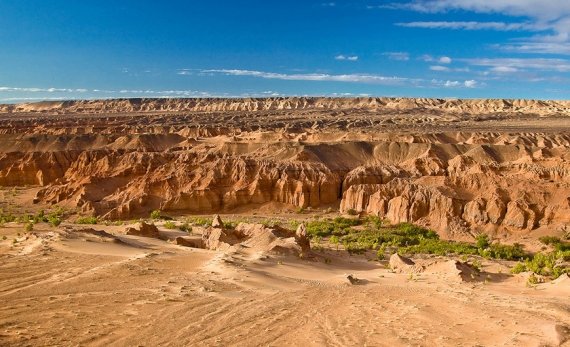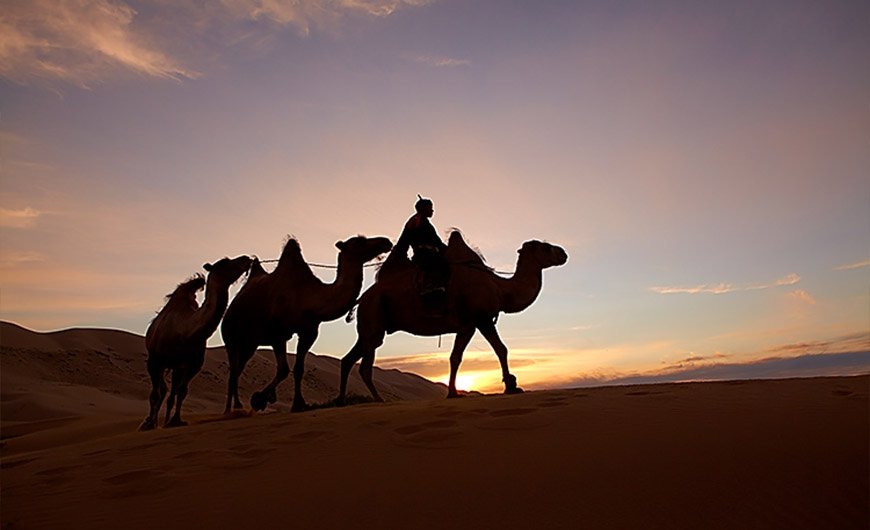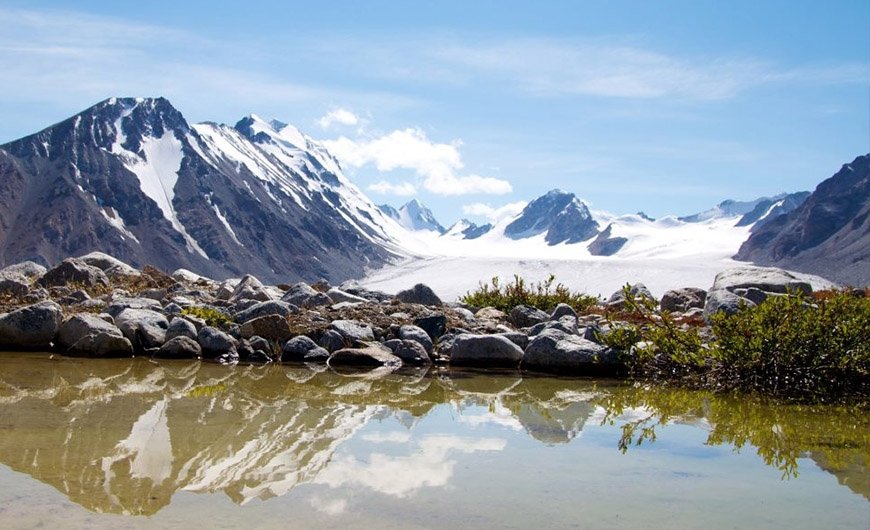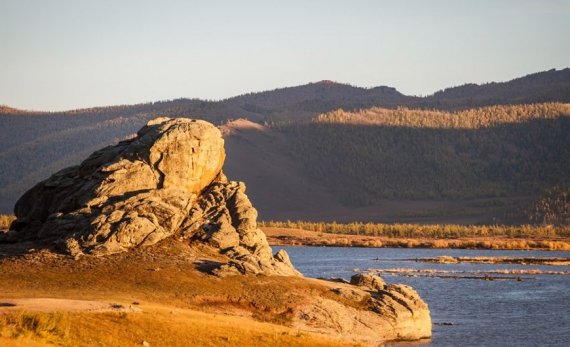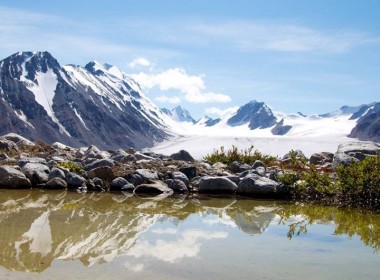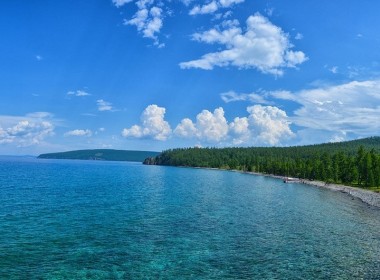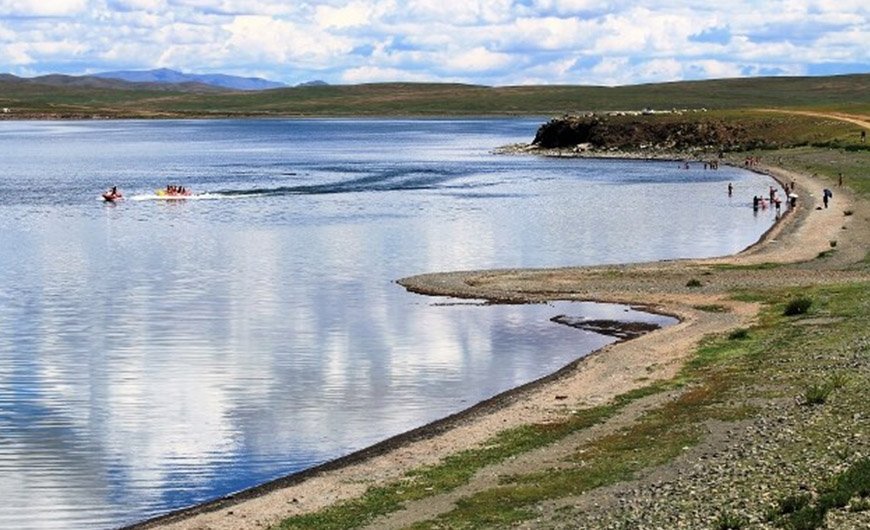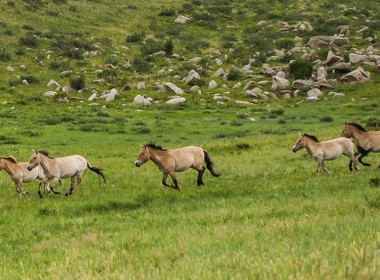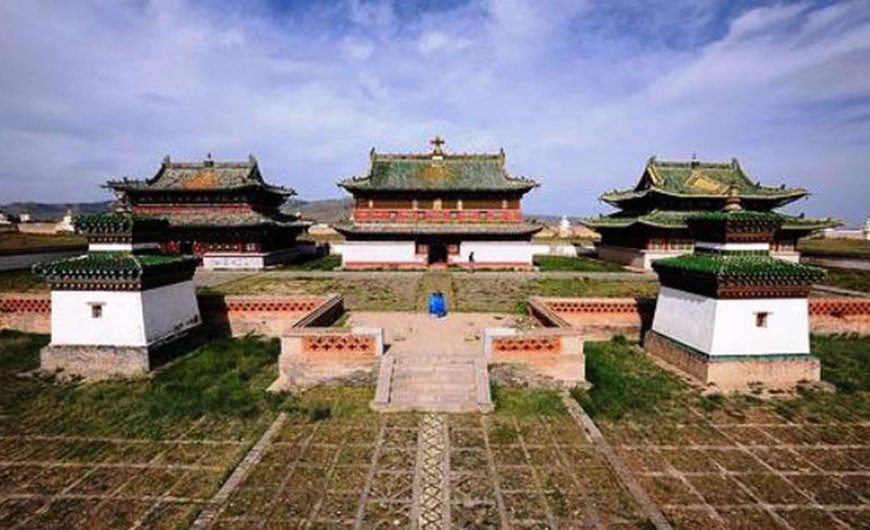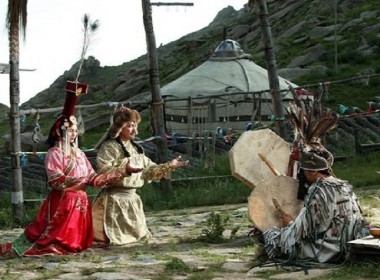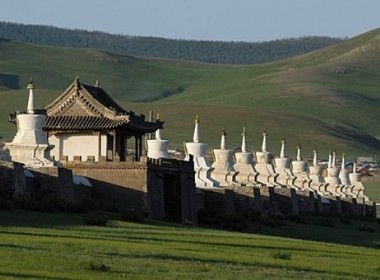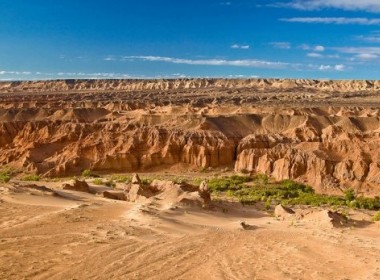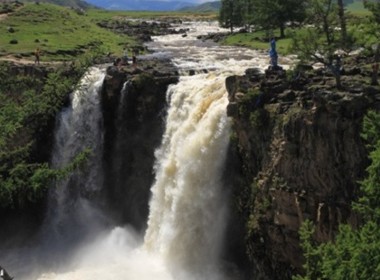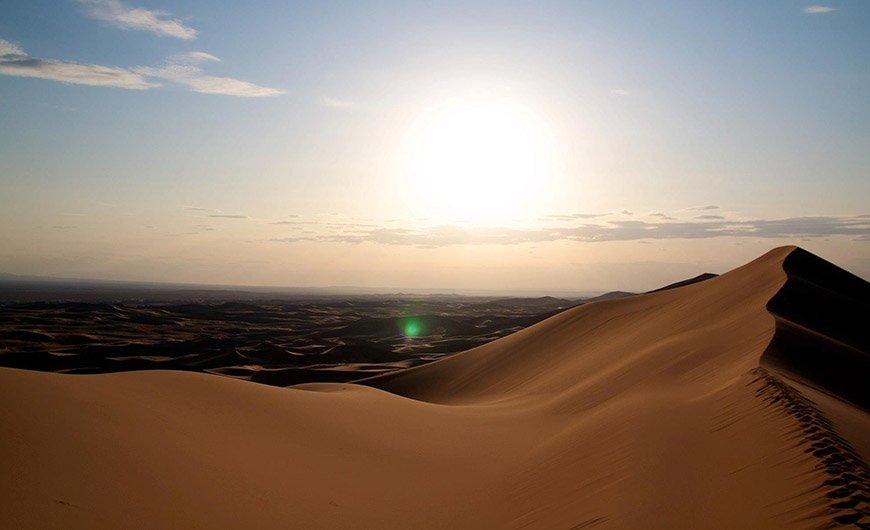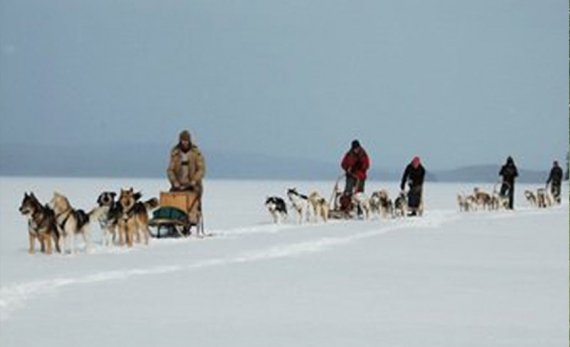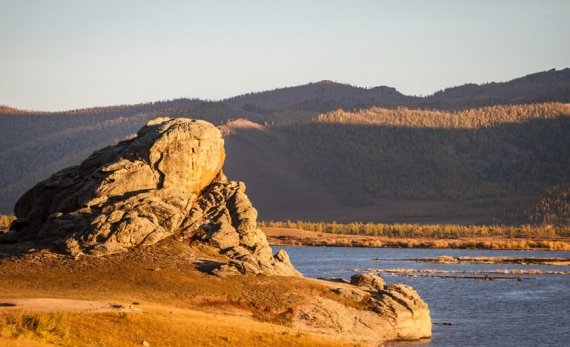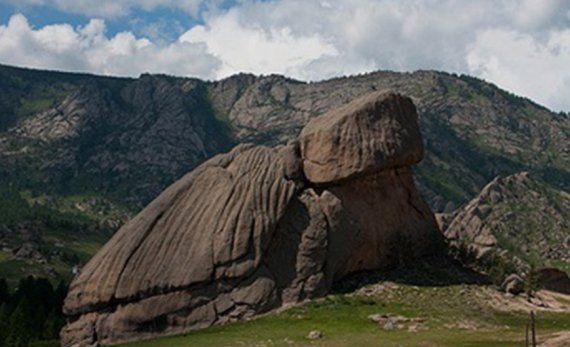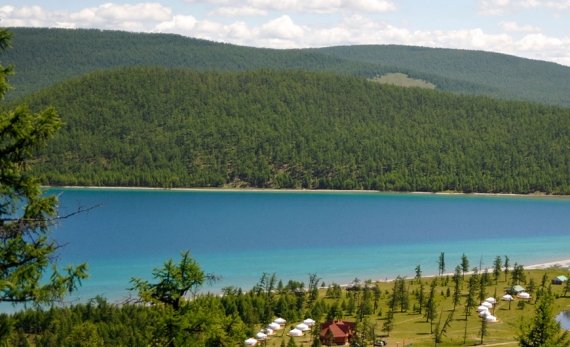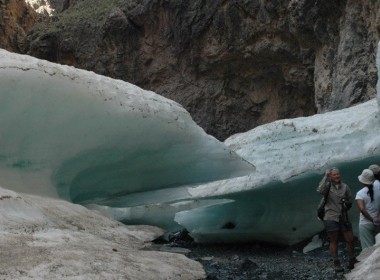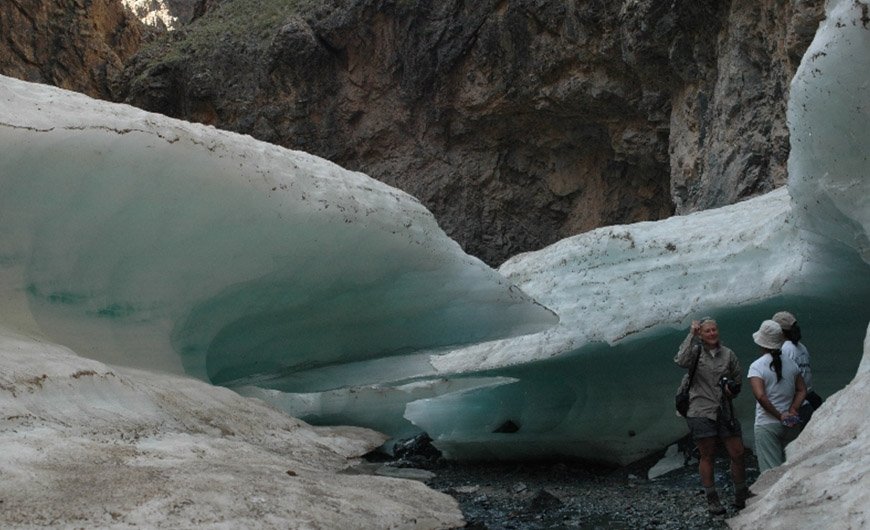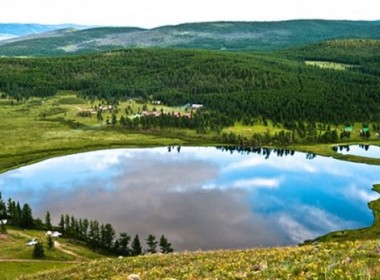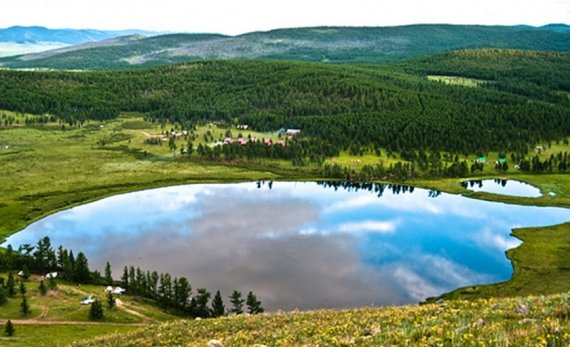Western Mongolia
Western Mongolia
Western Mongolia is a region in Mongolia covering the provinces of Bayan-Ulgii, Hovd, Uvs, and Zavkhan. It is the most remote region of the country with paved roads from the capital, Ulaanbaatar, ending 200 miles before reaching the eastern most point of Zavkhan. It is also the most ethnically diverse, mountainous, and scenic region of Mongolia, with thousands of years of history. The region is home to the Kazakhs, a Muslim tribe from near the Caspian Sea, and Oirats, or western Mongols, which can be divided into 10 different tribes, as well as Khalkhs, or eastern Mongols. In addition to the ethnic diversity, the region is home to the Altai Mountain Range, with the highest peaks in Mongolia, Lake Uvs, a large saltwater lake, and many smaller lakes, mountains, rivers, forests, and steppe. Spread throughout the region are countless archeological sites with petroglyphs, cave paintings, standing stone monuments, monasteries, and ancient forts that date back as far as 10,000 years.
Western region of Mongolia has for much of its history been on the boundary between civilizations, between Chinese dominated Asian culture to the east and European cultures to the west divided by the Altai mountains and the Tibetan plateau to the south with only a narrow gap just south of what is today Mongolia. This location near the crossroad of civilization has left the landscape littered with history of many groups either originating in these mountain valleys or passing through on their way to conquest. Over the last 10,000 years, the Blue Turks, Scythians, Tuvans, Hun, Mongols, Uighurs, and Kazakhs all spread out from or through the region to take over more settled peoples. It wasn't until the 1930s that all of the Altai mountains was firmly controlled with fixed borders by outside powers, and even then only after many years of bloody resistance. This legacy of independence can still be seen in the customs of the diverse population which can be broadly divided into Kazakhs, Tuvans, Khalkh Mongols, and Oirat Mongols (which can be divided into roughly 10 distinct tribes). These groups have adapted their cultures to handle the difficulties of living in this cold, dry, mountainous place. This region with the Altai Mountains in the west, Gobi Desert in the east and south, the Great Mongolian Lakes depression in the north and center, and forests, steppe, and deserts mixed throughout support some rare and spectacular wildlife. Large and endangered animals call the region home including snow leopards, the Govi Bear, Argali sheep, ibex, antelope, gazelle, falcons, golden eagles, wolves, foxes, and many more. Many more birds use the many lakes as rest stops on their annual migration between Siberia and Southeast Asia.
Uvs Lake Information and Facts
Uvs Lake is the largest lake in Mongolia by surface area, and also the largest saline lake in the country. The lake area is one of the most important biodiversity poles in Eurasia.
Geography
Uvs Lake is a highly saline lake in the endorheic Uvs Nuur Basin, which ranges from the permanent snowfields of the Turgen mountains over the lakes and wetlands area, towards the Desert of Altan Els. Uvs Nuur is part of a special protected area, together with the Altan Els Sand Dunes and Mount Tsagaan Shuvuut. The lake is bordered by the Tannu Ola Range on the north and the Sangilen Mountains in the northeast. The largest settlement in the lake area is the city of Ulaangom on the south. Although the majority of Uvs Lake sits in Mongolia, its northeastern tip is located in the Tuva Republic of the Russian Federation.
The lake is shallow, very saline, and is the remnant of a large saline sea, which existed several thousand years ago. Its salinity is mainly due to its sulphate and sodium ion concentration. Uvs has an average depth of 6 meters. The lake basin is separated from the Great Lakes Depression by the Kjan Khokii ridge.
The basin covers an area of approximately 70,000 km2 and it represents one of the best-preserved natural steppe landscapes of the continent. It is here that the westernmost northern desert meets the most southern tundra zone of the World. The basin is home to several smaller lakes compared to Uvs Lake, which all make up an important destination for waterfowl migration.
Protection and Science
The lake and its surrounding area have been declared protected sites. The UNESCO “Uvs Lake Site” is merely an umbrella term for not only the lake, but also the 12 separate clusters of protected sites, each representing a major Eastern Eurasian biome.
The lake was chosen as one of 10 study areas of the International Geosphere-Biosphere Programme, in aim of understanding global change in our Planet’s atmospheric, biological, geological and hydrological systems.
Climate
The lake basin spans the geoclimatic boundary between Siberia and Central Asia, thus having extreme temperatures ranging from -58OC to 47OC. It has a harsh extreme continental climate, with warm summers and long, very cold winters. Average summer temperatures range between 20-22OC, whilst average winter temperatures are between -32 and -35OC. The basin is in the rain shadow of the Tannu Ola Mountains, so precipitation is between 150-200 mm yearly, 70-80% of it coming from summer showers and thunderstorms. The lake freezes from October to May every year.
Hydrology and Ecology
Uvs Lake has over 38 tributaries, of which the Tes-Khem River is the most important. Nariin, Kharkhiraa, Turgen, Sagil, Borshoo, Khundulun, and Torkhilog are other important inflows. There are 9 strictly protected areas in the lake basin, which represent the main ecosystems.
Because the population density in the area is low, and there’s no industry in the region, people live a more traditional lifestyle, which consists mainly of nomadic pasturing. This causes little impact on the lake basin, thus the ecosystem has remained pure and pristine.
The reed beds and the freshwater river deltas are significant resting and nesting places for numerous migratory species. More than 220 bird species can be found at and around Uvs Lake, including black storks, osprey, white-tailed eagles, whooper swans and black-headed gulls. More than 100 pairs of spoonbills also breed in the region. 29 different fish species can be found in the lake, of which one is suitable for human consumption. The mountain area is home to the Mongolian gerbil, the snow leopard, the wild sheep and the Asiatic Ibex.
Cultural Heritage
Uvs Lake has been included in the UNESCO World Heritage Sites List in 2003. It was nominated as “one of the largest intact watersheds in Central Asia”, where more than 40,000 archaeological sites can also be found, which once belonged to historically famous nomadic tribes like the Scythians, the Turks and the Huns. This represents one of the largest sites on the UNESCO List. This cultural heritage site is very important, since it also contains burial mounds (kurgans) and stone tablets (steles) of which many date back to the Paleolithic Era.
Name
The lake’s name derives from the Mongol word “subsen”, which refers to the bitter sediment that is left behind in the process of making a Mongolian milk wine called “airag”. The word “nuur” is Mongolian, meaning “lake”. The name “Uvs” is a reference to the saltiness of the lake’s waters.
Otgontenger Mountain
Mount Otgontenger is the highest peak of the Khangai Range. It’s located in the province of Zavkhan, East Uliastai. In 1992, the Mongolian government delimited a strictly-protected areaaround the peak. This area covers an area of 1055 square kilometres (407 square miles). Specialists are not in agreement about its altitude. Until today, you could see on most of the maps, that the mount was 4021 metres (2.5 miles) above the sea level. Today the surveyors agree that the height is 4008 metres (2.49 miles).
Mount Otgontenger is the only peak of the Khangai Range that is covered with a permanent glacier. The Southern face of the mount is composed of the largest granite wall of all the country. At the foot of the mountain, we find Lake Badarkhundaga.
Mount Otgontenger is part of the three most sacred summits of the country, and it’s strictly forbidden for women to climb it. According to the Mongolian traditional beliefs, angry gods live in the sacred mountains of Mongolia. God Ochirvaani is reported as living in Mount Otgontenger.
Khar Us Nuur National Park
The main lakes are Khar Us Nuur, Khar Nuur and Dorgon Nuur. The national park was established in 1997, and then designated as a Ramsar (wetland of international significance) site in 1999. The lakes have the largest reed beds in Central Asia. Surrounded by desert landscapes, it is surprising to find that rare wild boars can survive in the reeds. Saiga antelope, though rare, have increased in later years, migrating through the park. Nearby Jargalant Hairkhan Mountain have Snow Leopards, Argali Sheep and Siberian Ibex. The mammals are, however, difficult to observe. For this reason, the many species of birds, the landscape and encounters with local nomads are the main attractions here.
The avifauna include Black-throated Divers, Arctic Loon, Red-crested Pochard, Swan Goose, Relict Gull, White-headed Duck, Pallas’s Fish Eagle, Dalmatian Pelican, Great Cormorant, Great Sand Plover and Great Egrets, observable by the lakesides and straits. On Jargalant Hairhan Mountain you have a reasonably good chance of seeing Wall creeper, White-Throated Bush-Chat, Eurasian and Cinereous Vulture, Lammergeier, Chukar, Altai Snowcock, Golden Eagle and Steppe Eagle.
Approximately 20 000 people live in and adjacent to Khar Us Nuur National Park. Most are nomads with some 200 000 livestock. Their migrations here may cover a fairly long distance, as precipitation is on average only 120mm per annum and sometimes as little as 70mm. Also, the lakeside has too many mosquitoes in the summer, why the herders usually take their livestock to higher altitudes.
The people of Chandmani soum claim that Hoomi (throat singing) originated in their area. Chandmani is located east of Jargalant Hairkhan Mountain. The water run-off from the mountain creates unusual habitats with birch groves on an otherwise arid desert steppe. Further east you will find Dorgon Nuur, which is a salt and alkaline lake, having no outlets. As such, it supports just sparse vegetation why there are no mosquitoes (as do the other lakes in July and August). Mongolia’s biggest sand dunes – Mongol Sands – end abruptly on the eastern shore of the lake, creating a Mongolian Riviera of sand beaches.
To the east of Khar Us Nuur National Park, in the buffer zone, is another unique release site for Przewalskii’s Horse (Equus przewalskii), a fenced reserve next to the Zavkhan River which flows through and next to sand dunes. The conservation project has great success by Takh Association of France, with a resident French biologist and Mongolian rangers at all times.
Hökh Serkhiin (Blue Goat) Mountains, a national park in the Altai Mountains which hosts all the Altai mammals, including Snow Leopards, Argali Sheep and Siberian Ibex.
Mongol Els Dunes are located in North Gobi-Altai, they extend from the province of Zavkhan at East, until the province of Khovd at extreme West. They extend on about 330 kilometres (205 miles) in the basin of the Zavkhan River, going towards its source. From the top, Mongol Els Dunes present a remarkable view on Lake Ereen Nuur, a rather marshy stretch of water near whose it can be dangerous to go.
In the Western dunes, located in the basin of the Zavkhan River, province of the Gobi-Altai, the popular medicine uses sand bathes for therapeutic purposes.
Great Lakes Depression
The Great Lakes Depression, also called the Great Lakes' Hollow is a large semi-arid depression in Mongolia that covers parts of the Uvs, Khovd, Bayan-Ulgii, Zavkhan and Govi-Altai aimags. Bounded by the Altai in the West, Khangai in the East and Tannu-Ola Mountains in the North, it covers the area of over 100,000 km2 (39,000sq mi) with elevations from 750 to 2,000 m (2,460–6,560ft). The depression is named so because it contains six major Mongolian lakes: saline Uvs Nuur, Khyargas Nuur and Dorgon Nuur; and freshwater Khar-Us Nuur, Khar Nuur and Airag Nuur. In addition, it includes 14,000 km2 (5,400sq mi) of solonchaks and large sandy areas. Northern parts are dominated by arid steppe and southern by semi desert or deserts. The major rivers are Khovd River, Zavkhan Gol, and Tesiin Gol.
The depression is a major freshwater basin of Mongolia and contains important wetlands of Central Asia. The wetlands are based on the system of interconnected shallow lakes with wide reed belts within a generally desert steppe. The wetlands support a number of rare migrating birds: Eurasian spoonbill (Platalea leucorodia), black stork (Ciconia nigra), osprey (Pandion haliaetus), white-tailed eagle (Haliaeetus albicilla), swan goose (Cygnopsis cygnoides), and bar-headed goose (Anser indicus). Only a few individuals of great white pelican (Pelecanus onocrotalus) remain in the Great Lakes Basin in Mongolia. They nest in catchment areas of rivers and lakes that have abundant fish and vegetation.
Although the total number of fish species in the region is low, a large percentage of those that do occur are endemic or near-endemic, especially from the genera Oreoleuciscus (Altai osmans), Thymallus (graylings) and Triplophysa (a stone loach genus).
Khyargas Lake
The Khyargas Lake is one of the four lakes which cover more than 1000 square. Khyargas lake is elevated at 1023 m above sea level that is in the south of Uvs province, descended from tectonics, covered 1406.8 km2 square, 75 km length, 31 km width, 253.8 km length shore, 92 m depth of water nearby yellow berry line and in other places about 40-50 m depth in there. Khan Khukhii Mountain laying behind of Khyargas Lake is damaged from rainwater thus there are many creeks and chutes. And the south side of the Khyargas lake looks so beautiful that seems jutting the marble white rocks. Khyargas lake has many kinds of fishes that are pikes, herrings of Altai, herrings of Nokhoi and the migratory birds, which are rare, foregather mostly in the surround of the lake thus there is a gorgeous native land wherever unrepeatable.
Khar Us Lake
Khar-Us, black water, is a freshwater lake located in the south of Khovd city, 1157 metres (3795 feet) above the sea level. It extends on 72 km (45 miles) long and 37 (23 miles) kilometres wide. It’s very little deep : between 2 and 4 metres (6,5 – 13 feet) deep average. It has 3432 km3 of water. It’s the upper lake in a system of interconnected lakes, known as the Great Lakes Depression. The Khovd, the Buyant and the Tsenkher Rivers flow into Khar-Us, while the Chono Kharaikh River has its source in it.
Lake Khar-Us has geological specificities, its boggy banks are overhanged with peaks covered with perpetual snow. In the middle of the Lake, we find Ak-Bashi Island, whose name means “white head” in Kazakh. This island separates the Lake in two parts, the Southern part and the Northern part. It’s located at 272 metres (892 feet) from the banks of the lake.
This little saline lake, located 100km away from Ulaangom, the capital of Uvs province, is between the Turgen and Tsagaan Shuvuut mountains. The lake stretches over 19.5km for 18km width for 65.5km shoreline length. Several rivers and streams such as Tsagdul and Kharigiin flow into its waters. Water temperature ranges between 14-15°C at the mouth of the lake with Kharigiin river, and is 12-13°C in central part. During winter time, from October to May the lake freezes with 1,2-1,5 meters thick layers of ice. Uureg is a semi-desert region with an arid vegetation, reminding the region of Gobi. It is the home of threatened species such as Swan Goose and Pallas’s Fish-eagle. On the site also live typical species of the Eurasian steppes such as Red foxes and Pallas’s Cats.
Kharhiraa. First off, there are several Kharkhiraas. For information on Kharkhiraa Uul and Kharkhiraa Gol see the section below. A more accessible valley, also known as Kharkhiraa, lies further north-east, about 30km east of Ulaangom. Bear in mind that Kharkhiraa is also the name of a sum center, 23km south of Ulaangom.
Though smaller than the Kharkhiraa Gol, this valley is surrounded by dense pine forests, has a crystal-clear river (from which it's safe to drink) and is often carpeted with flowers. It is a fine place for some day hikes.
Kharkhiraa uul and Turgen uul. The twin peaks of Kharkhiraa Uul (4037m) and Tiirgen Uul (3965m), which dominate the western part of the aimag, are curiously almost equidistant between Achit, Uiireg and Uvs lakes. As vital sources of the Uvs Nuur, the mountains are part of the Uvs Nuur Strictly Protected Area.
The river valley between the two mountains is the Kharkhiraa Gol, which flows into Uvs Nuur. This valley is the start of some excellent trekking routes, which lead up to both mountains, and you could also do some fine day hikes around here with your own jeep and camping equipment. The area is mostly populated by Khoton people, famous throughout Mongolia as shamans.
There are remains of some Uighur statues in the region, but you'll need a guide to find them.
Altan Els. The road between Ulaangom and Moron passes the Boorog Deliin Els sand dunes, which apparently form the northern most desert on earth. The sand dunes lead to Altan Els (Golden Sands), part of the Uvs Nuur Strictly Protected Area. Altan Els is another wonderful area for wildlife, if you can find any. The Altan Els are on the border of Uvs and Zavkhan aimags, and are an easy detour from the Ulaangom-Moron road.
Olgii Nuur. To confuse things a little, another freshwater lake in the region is called Khar Us Nuur, but it is sometimes referred to as Olgii Nuur. The 20km- long lake is accessible, but is not quite as scenic as Ulireg and Achit lakes. You can swim and fish in Olgii Nuur, but the camping is not as good - the winds can be horrendous, so pitch your tent securely.
Uureg Nuur. Large and beautiful Uiireg Nuur (1425m above sea level) is surrounded by stunning 3000m- plus peaks, including Tsagaan Shuvuut Uul (3496m), part of the Uvs Nuur Strictly Protected Area. The freshwater lake has some unidentified minerals and is designated as 'saltwater' on some maps, so it's best to boil or purify all water from the lake.
The lake is great for swimming (albeit a little chilh) and locals say there are plenty of fish. The surrounding mountains are just begging to be explored.
Achit Nuur. The largest freshwater lake in Uvs, Achit Nuur is on the border of Uvs and Bayan-Olgii aimags, and is an easy detour be-tween Ulaangom and Olgii. It offers stunning sunsets and sunrises and good fishing.
The lake is home to flocks of geese, eagles and other birdlife. One definite draw-back is the absolute plethora of mosquitoes during the summer.
Altai Tavanbogd Natural Park. This stunningly beautiful park stretches south from Tavanbogd Uul and includes the three stunning lakes of Khoton Nuur, Khurgan Nuur and Dayan Nuur. It's a remote area, divided from China by the high wall of snowcapped peaks, and known to local Kazakhs as the Syrgali region.
All three lakes are the source of the Khovd Gol, which eventually flows into Khar Us Nuur in Khovd aimag. It's possible to make rafting trips down river from Dayan Nuur, though no agencies offer this at present.
There are many archeological sites in the region. As the main road through the region swings towards the southern shore of Khurgan Nuur you can see a stupa-like construction and several burial sites. Nearby is a balbal (Turkic stone statue) and the remains of a processional pathway. Further along the road is a wooden Kazakh mosque, with a ger-shaped roof.
Further north-west, along the south-western shore of Khoton Nuur, the road deteriorates and there are several rivers to cross as they flow into the lake. North-west of Khoton Nuur the mountains close in and there's some fine trekking possibilities.
Tavanbogd (Five Saints) mountain rises 4374m above the borders of three nations, and for this reason it is also known as Nairamdal (Friendship) Peak. If you sit on the summit, you can simultaneously be in Mongolia, China and Russia (though you won't need a visa for all three).
Tavanbogd is one of Mongolia's most spectacular peaks, of interest to professional climbers, and the only one in Bavan-Olgii to be permanently covered with large glaciers (including the 19km long Potanii Glacier, the longest in Mongolia). It's fairly dangerous, and to climb it you need to be with an experienced group properly equipped with ice axes, crampons and ropes. Don't even consider attempting it solo. The best time to climb is August and September, after the worst of the summer rains.The massif is made up of five peaks (the five saints) - Khuiten, Naran, Olgii, Buraed and Nairamdal - the highest of which is Khuiten (meaning 'cold') at 4374m.
Tolbo Nuur. Tolbo Nuur (Frog Lake) is about 50km south of Olgii, on the main road between Olgii and Khovd city, so it's an easy day trip or stopover. The saltwater lake is high (2080m), expansive and eerie, but a bit disappointing because the shoreline is treeless. There are a few gers around the lake, and the water is clean enough for swimming if you don't mind icy temperatures. If you want to see, and camp at, some better lakes, keep traveling on to Uvs aimag.
Tsambagarav Mountain National Park
This 110,960 hectare park surrounds the snow-capped, 4193m (13,737ft) Tsambagarav Mountain, which is sacred to Mongolians. On the border between Bayan-Ulgii and Hovd provinces, the park has beautiful scenery, rich wildlife, plenty of archeological sites, and native nomadic Kazakh and Uriankhai herders living in the shadow of the holy mountain.
The center of the park is Tsambagarav and the 4165 m (13,645ft) Tsast Mountain. Both mountains and several others are permanently snow-capped. Below the peaks are many glaciers and glacial lakes. These glaciers have left deep rocky gorges that have many waterfalls including one 7 m (23ft) one on the north side of the park. During summer, the valleys north of the mountain are very green and full of wildlife, livestock, and flowers.
Khoton Lake
Khoton Lake is a freshwater lake in Altai Tavan Bogd National Park in Bayan-Ulgii Province. It lies at the foot of the Altai Mountains near the Chinese border, at an elevation of about 2,000 meters (6,600ft) above sea level. It is fed by the Khuiten River from the east and other rivers from the north. With an area of 50 square kilometers (19sq mi), it is the country's twenty-sixth largest lake by surface area. It has a maximum depth of 8.58metres (28.1ft). The lake is home to abundant fish life.
Khurgan Lake
Khurgan lake located in the northern part of the Altai mountain range, streches over 23 km long and 6 km wide. Towered by glaciers, the waters of the lake mainly originate from the glacial meltwater, maintaining hence a low temperature of 8 to 10 degrees celsius in June. It’s from October that the surface of the lake starts to freeze, creating then 1.3-1.6 m ice thickness.
This exceptional place, sets in dazzling scenery, offers an unspoilable view on the glaciers and their snow-capped mounts; besides the 20 emerging islands. The forests along the shorelines and the hills surrounding the lake are the home of many species of birds such as whooper swan, goose, eagle, hooded crane and various species of ducks. Also, during the flyway migration, it is possible to observe on the site: pelicans, ruddy shelducks, northern lapwings and common goldeneyes.
Khoid Tsenkher Cave
Khoit (Khoid) Tsenkheriin cave, the longest cave of the Mongol Altai mountain chain. The cave is formed in the limestone of the Proterozoic period. This cave is located 25 kilometers southwest of Mankhan sum Khovd province, at 47°20'50.5" N and 91°57'24.1" E, along the Khoit Tsenkher River.Khoit Tsenkheriin cavehas two branches. The main passage is 130m and 90m.
Khoit Tsenkher cave is famous rock paintings. Rock paintings of the Khoit Tsenkher cave date back to the Upper Paleolithic period (20,000-15, 000 years ago).The detailed description of rock paintings in 1966 the Mongol-Soviet historical and cultural expedition under the direction of archeologist the archeologist of professor A.P.Okladnikova.
In one of corners of the cave measuring 2.5 m high and 1.5-2.0 m deep, numerous symbols and animals were painted overlapping each other on the ceiling and wall. Lions, elephants, argali sheep, ibexes, ostriches, antelopes, camels, as well as symbols were painted with mineral-based paints of rosy and brown colors on the walls deep inside the cave. Some particular parts of the animals such as their horns, necks, humps are depicted with an exaggerated hyper-realism typical of the Paleolithic period.







